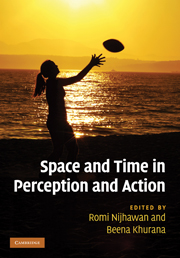Book contents
- Frontmatter
- Contents
- List of contributors
- Acknowledgments
- 1 Space and time: the fabric of thought and reality
- Part I Time–space during action: perisaccadic mislocalization and reaching
- Part II Temporal phenomena: perception
- Part III Temporal phenomena: binding and asynchrony
- Part IV Spatial phenomena: forward shift effects
- Part V Space–time and awareness
- Index
- References
1 - Space and time: the fabric of thought and reality
Published online by Cambridge University Press: 05 October 2010
- Frontmatter
- Contents
- List of contributors
- Acknowledgments
- 1 Space and time: the fabric of thought and reality
- Part I Time–space during action: perisaccadic mislocalization and reaching
- Part II Temporal phenomena: perception
- Part III Temporal phenomena: binding and asynchrony
- Part IV Spatial phenomena: forward shift effects
- Part V Space–time and awareness
- Index
- References
Summary
Space and time are modes by which we think and not the conditions in which we live.
–Albert EinsteinSince the beginning of sentience, the fabric of reality has been the subject of intense curiosity, and the twin concepts of space and time have figured prominently in the thinking of individuals of various intellectual persuasions. Understanding in science has advanced significantly through the postulates that underpin coherence and precision in the representation, and measurement, of space and time. These advances have formed the bedrock of the development of many disciplines. However, until the latter half of the nineteenth century many properties of space and time were assumed and therefore remained unquestioned. For example, the implicit acceptance of concepts such as absolute space (a coordinate system at rest, relative to which all inertial frames move at constant velocity) and absolute time (a universal time independent of any “clock” or mechanism) made most issues related to space and time impervious to empirical investigation and theoretical debate. This state of affairs was robustly challenged by scientists such as Ernst Mach, who among others imagined observers equipped with measuring devices (rulers and clocks) arriving at concepts at odds with notions of absolute space and absolute time.
Many well-known scientists whose work spanned the latter half of the nineteenth century (Mach included) crossed the disciplinary boundaries of physics, philosophy, and vision science. In Mach's thinking on space and time, the observer's sense perception played a critical role.
- Type
- Chapter
- Information
- Space and Time in Perception and Action , pp. 1 - 6Publisher: Cambridge University PressPrint publication year: 2010
References
- 1
- Cited by



